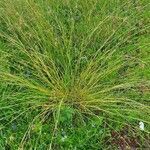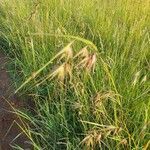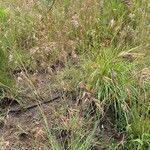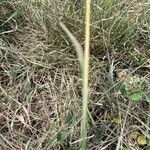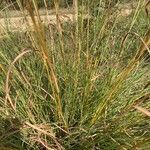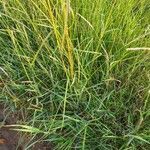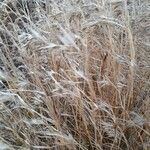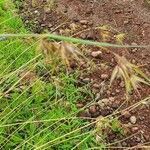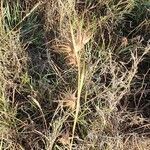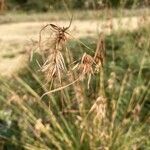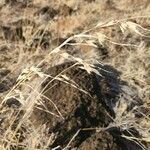Perennial from a knotty rootstock. Culms tussocky, yellowish, usually farinose near nodes, 0.5–1.5 m tall. Leaf sheaths usually hispid with tubercle-based hairs; leaf blades 10–50 × 0.4–0.8 cm, glabrous or pilose, finely acuminate; ligule 1–2 mm, truncate, ciliate. Compound panicle lax, open, with spaced, often nodding spathate fascicles; spathes and spatheoles narrowly lanceolate, glabrous or thinly to densely tuberculate-hispid, innermost 2–3.5 cm. Raceme composed of a triad of 1 sessile and 2 pedicelled spikelets above the involucre of 2 homogamous pairs. Homogamous spikelets all sessile, arising at same level, staminate, both glumes present, 7–14 mm, oblong-lanceolate with lateral scarious wings, glabrous or hispid with tubercle-based hairs. Sessile spikelet 5–7 mm; callus 1.5–3 mm, pungent, brown bearded; lower glume dorsally rounded, dark brown, glossy, hispidulous in upper 1/3, smooth below; awn 3.7–7 cm. Pedicelled spikelet 7–12 mm, male or barren. Fl. and fr. Jun–Dec. 2n = 20, 40, 50, 60, 70, 80.
Tufted perennial; culms 30 cm. to 2 m. high, erect.. Leaf-blades flat, up to 30 cm. long or more, and 1–8 mm. wide.. False panicle up to about 30 cm. long, composed of wedge-shaped clusters of 2–8 racemes enfolded by spatheoles and spathes; spatheole 1.5–3.5 cm. long, russet coloured, glabrous to tuberculate-pilose; raceme containing 1 fertile spikelet.. Homogamous pairs arising at about the same level; lower glume narrowly elliptic, 6–14 mm. long, glabrous to tuberculate-hirsute.. Sessile spikelet 6–11 mm. long, including a pungent rufously bearded callus 2–4 mm. long; lower glume brown, smooth except for the appressedly pubescent tip; awn 2.5–7 cm. long, puberulous.. Pedicelled spikelet 6–14 mm. long, glabrous or tuberculate-pilose; callus 2–3 mm. long.. Fig. 192.
Rhizomatous perennial, 0.3-1.5 m high. Leaf blade up to 300 x 1-8 mm, sheath compressed; apices abruptly or gradually tapering; ligule a lacerated, unfringed membrane. Inflorescence a leafy, false panicle of densely packed racemes in fan-shaped clusters enclosed in spatheoles and spathes; racemes very short, composed of a single, awned sessile spikelet and 2 pedicelled spikelets, the whole enclosed by an involucre of 4 sterile spikelets; internodes and pedicels linear, homogamous spikelets all sessile. Sessile spikelet 5-7 mm long; awn 25-70 mm long, stout, geniculate; anther 3.5-4.0 mm long. Pedicelled spikelet equalling sessile to somewhat longer, up to 8.5 mm long. Flowering time Sept.-June.
Perennial; up to 1.5 m high; rhizomatous. Leaf blades up to 300 x 1-8 mm; apices abruptly or gradually tapering; leaf sheaths compressed; ligule a notched membrane. Flowers: in a complex; false panicle; spikelets clustered in drooping; triangular units resembling a single spikelet; each unit usually 1-awned; rarely 2-or 3-awned; composed of a single; awned; sessile; bisexual spikelet and 2 pedicelled spikelets; enclosed by an involucre of 4 sterile sessile spikelets; sessile spikelets 5-7 mm long; pedicellate spikelets equal or somewhat longer; spathes reddish.
Perennial 300-1500 mm high; rhizomatous. Leaf blade to 300 x 1-8 mm, sheath compressed; blade tips abruptly or gradually tapering; ligule a lacerated membrane. Fertile spikelets and bract-like sterile spikelets are wedge-shaped or in drooping triangular clusters within reddish spathes. Sessile spikelet 5-7 mm, long-awned; anther 3.5-4.0 mm long. Pedicelled spikelet equalling sessile to somewhat longer, up to 8.5 mm long.
Perennial, rhizomatous, up to 1.5 m high. Leaf blades up to 300 mm long, 1-8 mm wide, leaf sheaths compressed, blade tips abruptly or gradually tapering; ligule a notched membrane. Spikelets (sessile) 5-7 mm long (pedicellate equalling it or somewhat longer), awned, in drooping triangular clusters with reddish spathes and bract-like sterile spikelets.
A herb. It is a grass which grows in dense tufts. It keeps growing from year to year. It grows about 1 m high. The leaves are coarse and narrow. They are 30 cm long. The stems are slightly flattened and smooth. The flower heads occur in stalked clusters. They are green and purple. They turn a rusty brown as they ripen.
False panicle up to c. 30 cm long, composed of wedge-shaped clusters of 2–8 racemes enfolded by spatheoles and spathes; spatheole 1.5–3.5 cm long, russet-coloured, glabrous to tuberculate-pilose; raceme containing 1 fertile spikelet.
Sessile spikelet 6–11 mm long (including the pungent rufously barbate callus 2–4 mm long); inferior glume brown, smooth except for the appressed-pubescent apex; awn 2.5–7 cm long, puberulous.
Homogamous spikelet pairs arising at about the same level, the internode barely perceptible; inferior glume 6–14 mm long, narrowly elliptic, glabrous to tuberculate-pilose.
Perennial to 80 cm. Leaves linear. Spikelets long-awned, in triangular clusters subtended by spathes, reddish, brown and yellow.
A most important grazing grass in eastern and southern Africa, where it is often a dominant constituent of grasslands.
Pedicelled spikelet 6–14 mm long, glabrous or tuberculate-pilose; callus 2–3 mm long.
Leaf laminas up to, or exceeding, 30 cm × 1–8 mm, flat.
Caespitose perennial; culms up to 200 cm high, erect.
Tufted perennial 1·2–1·8 m. high
Rusty brown spatheoles
